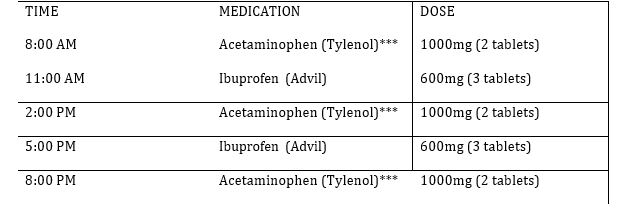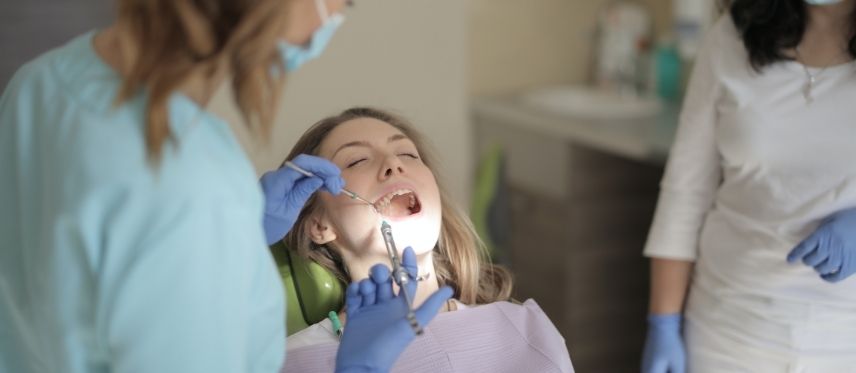Post-operative care is essential following oral surgery, and neglecting it might prolong healing. Expect some edema, stiffness, blood seeping, and discomfort after surgery. It is beneficial to have a responsible adult observe the patient throughout the entire surgical day. Following are our post-operative instructions and potential events that may occur following this type of surgery.
Bleeding: The gauze pad that was put after surgery serves as a protective bandage and should be left in place for two to three hours under light pressure. Leaking is to be anticipated. The presence of heavy bleeding is not typical. Usually, however, this may be controlled by placing clean gauze directly over the surgical site and applying hard pressure for around one hour, or until the bleeding is under control. Call the office at any time (682) 237-2353, or report to the emergency room if bleeding persists.
Sutures: The stitches that were placed are self-‐absorbing. There is no need to come back to the clinic to remove the stitches. Within five to seven days, stitches will dissolve completely. During this time, avoid drinking or eating anything particularly hot.
Pain: Alternate Ibuprofen (Advil) and Acetaminophen (Tylenol) every 3 hours for a minimum of 24 hours.

DO NOT exceed 2400 mg (12 tablets) of ibuprofen each day!!!
DO NOT exceed 4000 mg (8 tablets) of Tylenol each day!!!
***Replace Acetaminophen with your prescribed pain medicine IF discomfort worsens.
If necessary, you will be issued with a medicine prescription. The prescription can be filled at any pharmacy, and it should be used as recommended. Pain is to be anticipated soon after surgery, and it will peak within the first several hours.
Nausea: In the initial post-operative period, nausea is frequently exacerbated by the use of pain medication. Remember to avoid taking the pain medicine on an empty stomach. Post-operative nausea can be alleviated by consuming 1 ounce of a fizzy beverage such as Ginger Ale every hour for five to six hours. Before returning to your regular diet, you can consume a mild tea, broth, and soft foods.
Swelling: Inflammation and stiffness are to be anticipated. This edema may worsen over the course of the first two days, but should then begin to reduce. Using ice and heat, it is possible to regulate swelling to a certain extent:
Ice: Use an ice pack for the first 12 to 24 hours, placing it to the cheeks for 20 minutes at a time and then removing it for the same amount of time.
Heat: Warm, moist heat administered to the jaws on the second and third post-operative days might alleviate swelling and stiffness.
The stiffness that might sometimes arise is typically alleviated by applying heat, using gum intermittently, and beginning modest stretching exercises the day after surgery.
Nourishment: Nourishment should not be neglected. On the day of surgery, a light diet is recommended (instant breakfast, Jell‐O, soups, protein shakes, etc.). The next day, a gradual transition from a soft diet to a regular diet, as tolerated, may begin. The patient should refrain from using straws for many days, as doing so could dislodge the blood clot.
Bruising: Depending on the type of the conducted procedure and the individual, facial discoloration may last for three to five days after surgery. If this occurs, you should not be alarmed.
Oral Hygiene: On the day before operation, rinsing, spitting, and teeth brushing should be avoided. Beginning the day after surgery, frequent rinsing with warm, mild salt water is advised. In addition, brushing should be begun with caution, avoiding the surgery site for the first two days. Normal wound healing requires excellent oral hygiene. If Peridex/chlorhexidine is prescribed to you, use it as indicated.
Activities: The first twenty-four hours should involve limited activity. Rest quietly with your head elevated. At least three days must pass without smoking. Do not anticipate an immediate return to work or routine activities. Two to three days of relaxation are recommended, followed by gradual resumption of activities as tolerated. Vigorous physical activity and sports should not be resumed until the surgery areas are pain-free, edema has subsided, and the diet is as normal as possible. Typically, contact sports should not be resumed for around one week after surgery. After the majority of oral surgeries, wind instruments should not be played for at least seven to ten days.
Numbness: Frequently, the roots of the lower teeth are near to the lower jaw nerve. The nerve may be somewhat irritated during tooth extraction, resulting in numbness of the chin, lower lip, and lower teeth on that side. No one can really predict how long this will last, although it is seldom permanent.
Taste and Odor: There may be an unpleasant taste or odor after surgery. This is typically the result of inadequate cleaning in the area. In addition to regular rinsing and brushing, commercial mouthwash may be utilized.
Uncommon Problems: The potential of a dry socket, which is an extremely rare problem, is feared by many individuals. However, this may be the case if your pain is not eased by the pain medication. If possible, you should return to our office. Ear pain, difficulty swallowing, and difficulty opening and closing the jaws are symptoms that might occur with different regularity and are typically insignificant. Infrequently does swelling worsen after 5–7 days, but if it does, please contact our office at (682) 237–2353.
Emergency: If you experience trouble breathing, fever, severe bleeding, or any other worrying symptoms following surgery, you must contact our office and dentist or go to the emergency room immediately.
Women should be aware that certain antibiotics may reduce the effectiveness of birth control tablets. Please check with your pharmacist.


